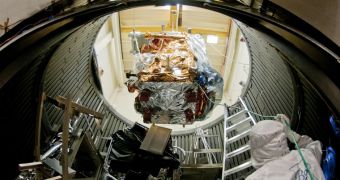Engineers at Boulder, Colorado-based Ball Aerospace announce that the NPP satellite has recently been put through another series of tests, this time to see whether it will withstand the conditions it will be subjected to during launch.
In order to do that, about 144 rock concert speakers were installed in a testing room the company uses for this project. Engineering teams created a circle using these speakers, which towered 16 (about 5 meters) feet above the ground.
The spacecraft was placed right in the middle of this circle, as soothing songs played. After all preparations were complete, the room was vacated, and everyone present put their earplugs on. A sound engineers then let the speakers roar.
This speaker circle was put together with a single purpose, that of simulating the roar and vibrations of the delivery system on which the NPOESS Preparatory Project (NPP) satellite will launch. NPOESS is the National Polar-orbiting Operational Environmental Satellite System.
When the speakers were activated, they reproduced the sounds made by thousands of pounds of rocket fuel as they explode and propel a rocket forward. The noise level slowly rose inside the test chamber until a level of 143.6 decibels was reached.
If a human was inside the test chamber, he or she would have suffered a great deal of internal damage due to the sound pressure, and would have very likely gone deaf, or worse. For comparison, an airplane taking off produces 140 decibels, while a shotgun produces 170 dB.
“I was outside the building when they did the full level acoustics and I could feel the ground shaking,” says NASA Goddard Space Flight Center (GSFC) NPP Chief Engineer Glenn Iona. This test is just one in a long series of assessments that the NPP must ace in order to get an approval for launch.
NPP is a prototype spacecraft showing how the next generation of Earth-observing satellites will look like. These probes will monitor daily weather and long-term ozone levels and climate change, which will in turn help experts develop better climate models.
Over the past 15 months, the NPP has been subjected to vibration, noise, controlled swings in temperature and electromagnetic radiation testing, and researchers had to resolve more than 107 so-called test anomalies that were produced during this time.
In the end, all five instrument in the satellite's science suite proved to withstand the harshest conditions experts could set up for them. In just a short while, the mission will have finished all its test.
At this point, the mission is scheduled to launch on October 25, from the Vandenberg Air Force Base (VAFB), in southern California, a NASA press release explains.

 14 DAY TRIAL //
14 DAY TRIAL //